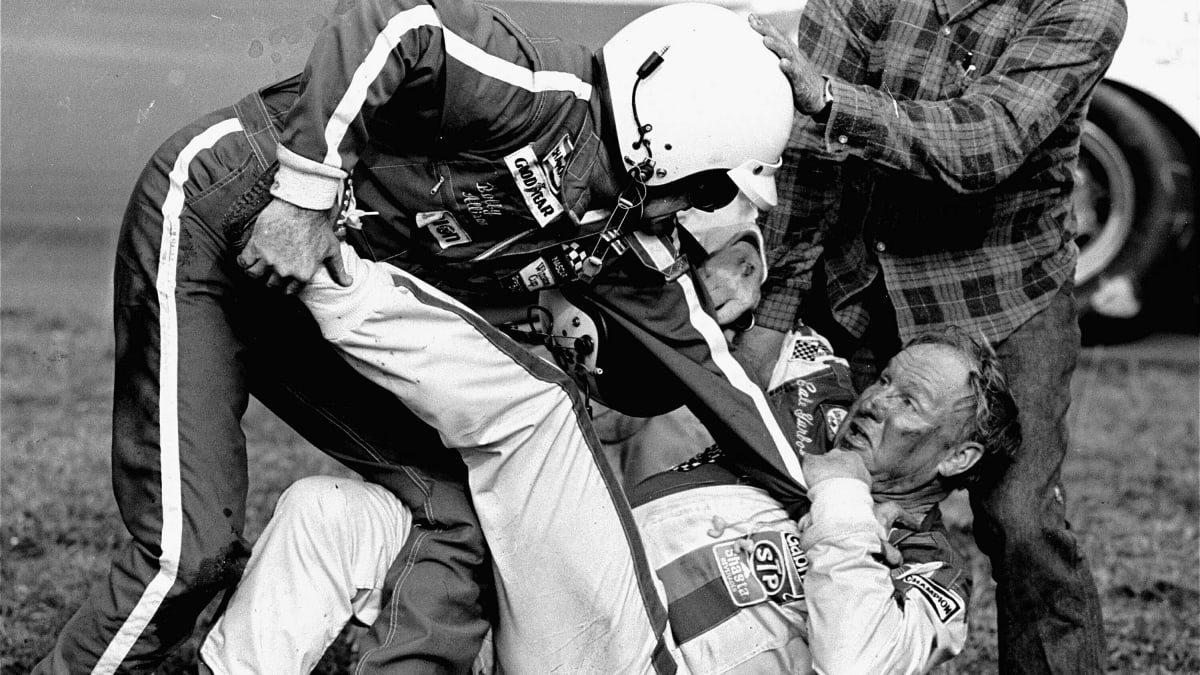Bobby Allison holds race driver Cale Yarborough’s foot after Yarborough, right, kicked him following the Daytona 500 on Feb. 18, 1979. (AP/Ric Feld)
DAYTONA BEACH, Fla. — Take a ride through Daytona International Speedway’s main tunnel, and photos of some of the most celebrated events in track history line the walls.
One can’t be missed.
It shows Cale Yarborough, helmet in hand, ready to unload on Bobby Allison and ignite a muddy, bloody slugfest in the 1979 Daytona 500 that turned the highly anticipated first live flag-to-flag broadcast of a race into a spectacle that stamped NASCAR on the national sports map.
Who were these good ol’ boys on TV fighting instead of racing?
The seminal moment legitimized the Daytona 500 in a flash — more like in a punch — and suddenly even traditional stick-and-ball fans were buzzing over NASCAR and the brawl that changed it all.
The fight was a viral clip before such a term was even a thing and it’s stood for 44 years near the top of the short list of most talked about, dissected and still-can’t-believe-it days over NASCAR’s first 74 years.
As part of the celebration of NASCAR’s 75th season, The Associated Press interviewed 12 veteran contributors to the industry on topics ranging from the greatest drivers to key challenges ahead.
With big names, a throwdown and a nation of viewers, the 1979 Daytona 500 was the winner in the AP survey as the most memorable race for its role as perhaps the most pivotal industry-changer in NASCAR history.
“While there are dozens of potential honorable mentions, this one seems to be replayed in highlight films more than any other, which helps it qualify as most memorable in addition to most pivotal,” said longtime Motor Racing Network announcer Winston Kelly.
Among the other races mentioned were Dale Earnhardt’s breakthrough 1998 Daytona 500 victory and Richard Petty’s 200th win in 1984 in the July Daytona race attended by President Ronald Reagan. Heck, Edsel Ford, long-time executive at the company that bears the name of his great-grandfather Henry Ford, couldn’t narrow it down to just one.
“I would say that any race that a Ford Motor Co. product won is my most memorable race,” Ford said.
All suitable nominees. But the 1979 Daytona 500 race — it was Petty’s sixth win in the crown jewel race — was something special. More than 15 million people watched the race and all its aftermath. It stood as the highest-rated NASCAR race until 2001.
The mayhem was triggered early in the race when Yarborough came up on brother Bobby and Donnie Allison and tapped Bobby’s rear bumper, sending all three cars careening through a muddy infield. All three drivers recovered, and Yarborough and Donnie Allison eventually battled for the lead before spinning out.
Yarborough later said Bobby Allison had slowed down to block him, then claimed Donnie knocked him into the grass. Bobby Allison had stopped his car near the crashed cars to see if Donnie needed a ride back to the garage. Yarborough confronted him through his window.
“He ran toward me and started yelling at me,” Bobby told the AP in 2019 for a 40th-anniversary remembrance. “And then he hit me in the face with his helmet, which really surprised me. I still had my seatbelts on. I had my helmet on, and that shielded me a little bit, but it cut my nose and my lips.
“By then, blood was dripping in my lap. I’ve either got to get out of the car and handle this or run from him the rest of my life. So I got out of my car and he went to beating on my fists with his nose.”
While Yarborough and Allison traded haymakers in the Florida sun, it was actually a snowstorm that helped broaden the race’s exposure.
The Daytona 500 was broadcast live in its entirety for the first time, reaching markets that knew little, if anything, about stock car racing. There was a blizzard that forced a large portion of the country inside. Cities were shut down, and TVs were turned on.
Deb Williams, an AP panelist now in her fourth decade of racing coverage, was pressed into service in her first year writing for UPI. She watched the race on TV at her parents’ home in North Carolina — snow blanketed the house outside — and later wrote the story from the Raleigh bureau about fans that had banded together to pay Donnie Allison’s $6,000 fine.
“There was just so much raw emotion of elements that people saw for the first time,” said Williams, who is covering her 29th Daytona 500 this year, for Autoweek.
And not for the last.
__
AP NASCAR at 75 voting panel: Edsel Ford, long-time Ford executive; Tony Gibson, retired NASCAR crew chief; Jeff Gordon, four-time NASCAR champion; Denny Hamlin, three-time Daytona 500 champion; Rick Hendrick, founder of Hendrick Motorsports; Jimmie Johnson, seven-time NASCAR champion; Winston Kelley, executive director of the NASCAR Hall of Fame; Steve O’Donnell, Chief Operating Officer for NASCAR; Richard Petty, NASCAR Hall of Fame driver; Lyn St. James, one of nine women who have qualified for the Indianapolis 500; Deb Williams, award-winning NASCAR journalist; Eddie Wood, co-owner of Wood Brothers Racing.
___

